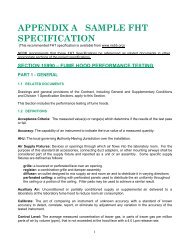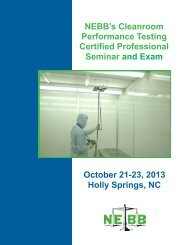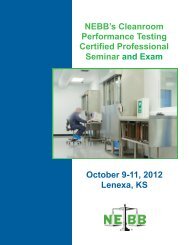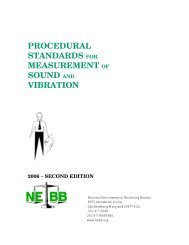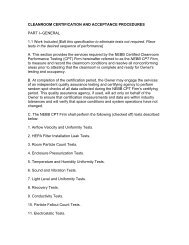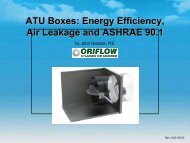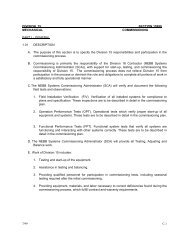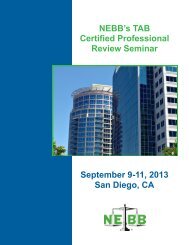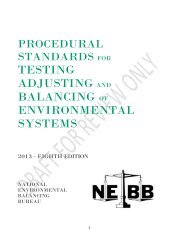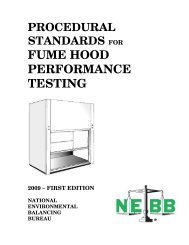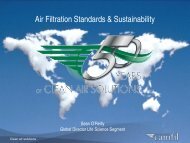THE NEBB PROFESSIONAL
THE NEBB PROFESSIONAL
THE NEBB PROFESSIONAL
You also want an ePaper? Increase the reach of your titles
YUMPU automatically turns print PDFs into web optimized ePapers that Google loves.
<strong>THE</strong> <strong>NEBB</strong> <strong>PROFESSIONAL</strong><br />
February 2011<br />
The Sound of Money<br />
<strong>NEBB</strong> Hits the Strip<br />
The Offi cial Magazine of the National Environmental Balancing Bureau
Since 1919, Alnor has provided rugged and<br />
reliable analog invstrumentation to HVAC<br />
technicians, and the tradition continues with the<br />
new Analog Balancing Tool (ABT) Balometer.<br />
The ABT series Balometer utilizes a low current<br />
analog meter with a large, easy to read scale.<br />
Fast meter response combined with smooth<br />
needle movement allows for quick<br />
and accurate flow<br />
measurements from<br />
supply diffusers and<br />
return grilles. For more<br />
information visit<br />
www.alnor.com<br />
The Phone: <strong>NEBB</strong> 800 Professional 874 2811 | Page E-mail: 2 customerservice@alnor.com
On the Inside...<br />
4<br />
6<br />
10<br />
16<br />
<strong>NEBB</strong> Hits the Strip<br />
Competing Smoke<br />
Control Systems<br />
Continuous Commissioning<br />
The Sound of Money<br />
Editor & Publisher<br />
Karen D. Groppe, PCM<br />
The <strong>NEBB</strong> Professional is a<br />
quarterly magazine published by the<br />
National Environmental Balancing<br />
Bureau, 8575 Grovemont Circle,<br />
Gaithersburg, Maryland 20877-4121<br />
phone: (301) 977-3698<br />
online at: www.nebb.org<br />
New Look for The <strong>NEBB</strong> Professional<br />
Welcome to the new look of The <strong>NEBB</strong> Professional! For the last two years, we are worked hard<br />
to develop effective content, secure advertisers and increase our subscription base. With each<br />
issue of The <strong>NEBB</strong> Professional, the magazine grows and improves. The magazine is developed<br />
at the National Offi ce and relies heavily on volunteers to author articles and share their expertise<br />
with our readership.To all those who have contributed to the magazine, thank you.<br />
This magazine was the vision of Eric Jenison, <strong>NEBB</strong> Past President and Former Marketing<br />
Committee Chairman. Eric wanted the magazine to serve as a resource, a promotion tool for<br />
<strong>NEBB</strong> Certifi ed Professionals, and an opportunity to inform and educate the industry. Although<br />
our magazine is still evolving, we are growing closer and closer to recognizing Eric’s vision.<br />
The <strong>NEBB</strong> Professional needs to hear from you. Submit story ideas, offer to author an article,<br />
share a case study on a <strong>NEBB</strong> project, review articles for technical content—but contribute<br />
your talents to the magazine. If you are interested in being a part of the magazine, please email<br />
Karen@nebb.org. As the old saying goes – It is easy to point out the problems, but it is better to<br />
be a part of the solution.<br />
The <strong>NEBB</strong> Professional | Page 3
<strong>NEBB</strong> Hits the<br />
Strip for<br />
the AHR Expo<br />
<strong>NEBB</strong> Joins 1800 exhibitors<br />
in Las Vegas<br />
As the largest and most comprehensive<br />
HVAC/R exposition, the AHR Expo was<br />
held at the Las Vegas Convention Center<br />
from January 31st -February 2nd. As it<br />
has been done in the last twenty years,<br />
<strong>NEBB</strong> continued the proud tradition of<br />
being an endorsing organization joining<br />
32 of the leading industry organizations in<br />
support the Expo.<br />
“We are proud to be an endorsing<br />
organization of AHR Expo,” said Karen<br />
D. Groppe, Director of Marketing. “ Our<br />
presence provides us with an opportunity<br />
to engage with potential <strong>NEBB</strong> Certifi ed<br />
Professionals, promote <strong>NEBB</strong> capabilities<br />
to building owners, contractors, while<br />
meeting with vendors and supporters of<br />
<strong>NEBB</strong> programs.” In 2011, more than<br />
500 visitors stopped by the <strong>NEBB</strong> booth<br />
for information on <strong>NEBB</strong> Certifi cation,<br />
publications and how to hire a <strong>NEBB</strong><br />
Certifi ed Firm.<br />
Since 1930, the AHR Expo has been the<br />
HVAC/R professional’s best resource<br />
for new products, new ideas and new<br />
services. It is a hands-on, interactive<br />
event that showcases a wide spectrum<br />
of equipment, systems and components.<br />
The AHR Expo is held concurrently with<br />
the Winter ASHRAE Meeting.<br />
The <strong>NEBB</strong> Professional | Page 4
<strong>NEBB</strong> Seminar Schedule 2011<br />
<strong>NEBB</strong> conducts several seminars to enhance the educational experience of each<br />
<strong>NEBB</strong> discipline.<br />
In June, 2011, <strong>NEBB</strong> TEC will be closing and <strong>NEBB</strong> will offer a regional approach<br />
to its training programs.<br />
For more information about <strong>NEBB</strong> Seminars, please visit www.nebb.org. Seminars<br />
are added and updated on a regular basis, please check back on the <strong>NEBB</strong> website.<br />
<strong>NEBB</strong> Seminar Dates Location<br />
Basic BSC Seminar March 7-11 <strong>NEBB</strong> TEC<br />
FHT Seminar March 14-18 Labconco, Kansas City, MO<br />
Advanced BSC Seminar April 11-15 Boland, Gaithersburg, MD<br />
Retro-Cx Seminar June 7-10 ASHRAE, HQ, Atlanta, GA<br />
FHT Seminar September 19-23 Labconco, Kansas City, MO<br />
Basic BSC Seminar November 7-9 MAEBA, Philadelphia, PA<br />
If your offi ce or chapter would be interested in conducting an S&V Seminar in your<br />
area, please contact Elana Noel, Director of Certifi cation at elana@nebb.org for details.<br />
The <strong>NEBB</strong> Professional | Page 5
Competing Smoke Control Systems<br />
Daniel Picciano, PE (MN), CFPS, Ryan Bierwerth, PE (WI), CFPS, Summit Fire Engineerings<br />
A Case Study in Elevator<br />
Shaft Pressurization with Stair Pressurization<br />
The Appleton Medical Center new Bed Tower included an<br />
addition to an existing building located in Appleton, Wisconsin.<br />
The design of the project occurred primarily in 2009, with<br />
construction being completed in the summer of 2010. As<br />
such, the applicable building code for the project was the 2008<br />
Wisconsin Commercial Building Code (WCBC), which is based<br />
on the 2006 International Building Code (IBC). Further, as a<br />
health care occupancy, the Authority Having Jurisdiction (AHJ)<br />
also enforced the 2000 edition of NFPA 101 Life Safety Code.<br />
The addition consisted of a new Bed Tower that is nine stories<br />
in height, not including a partial Basement. The construction<br />
of the Bed Tower is noncombustible, fi re-rated—Type I-B. The<br />
Appleton Medical Center proper is used as a hospital and<br />
medical offi ce building, including emergency rooms, surgery<br />
wings, cancer center, etc.; and, the Bed Tower addition consists<br />
primarily of patient rooms. As such, the primary occupancy in<br />
the Bed Tower is Group I-2 (Institutional). The main building<br />
and addition are provided with automatic fi re sprinkler protection<br />
throughout.<br />
The elevation of the top-most occupied fl oor of the Bed Tower exceeds 75 feet above the lowest level of Fire<br />
Department vehicle access; and, as such, the Bed Tower is classifi ed as a “high-rise” building. Prescriptively,<br />
the IBC requires high-rise buildings to be provided with additional protection for egress stairs and elevator<br />
shafts against the migration of smoke vertically throughout the building under a fi re condition. The IBC allows<br />
various options for providing the necessary protection of egress stairs and elevator shafts, including both<br />
passive and active means that are capable of satisfying the intent.<br />
For taller egress stairways, “smokeproof enclosures” are required. Traditional methods of providing smokeproof<br />
enclosures are fairly well-established in the construction industry and have been utilized over the years –<br />
via both passive and active means. Although the code allows for passive means of providing smokeproof<br />
enclosures, active systems are often more preferable from an architectural standpoint. For example, exterior<br />
vestibules – an available option for passively providing smokeproof enclosures – is likely infeasible for egress<br />
stairs that are interior to the building footprint. As such, it is very common for egress stairways to be provided<br />
with mechanical stair pressurization as a means of complying with the smokeproof enclosure requirements<br />
of the IBC.<br />
The <strong>NEBB</strong> Professional | Page 6
Competing Smoke Control Systems<br />
Elevator shafts, on the other hand, have historically<br />
been protected using passive means – such as<br />
enclosed elevator lobbies, additional (UL listed)<br />
doors, etc. Enclosed elevator lobbies tend to be the<br />
most cost-effective solution, even though they are<br />
oftentimes not desirable. With the 2006 revision to<br />
the IBC, however, an additional option was included<br />
to allow mechanical pressurization of the elevator<br />
shaft in lieu of providing enclosed elevator lobbies.<br />
For the first time, elevator shafts were permitted to be<br />
protected with active systems, similar (in concept) to<br />
the stair pressurization systems commonly utilized in<br />
egress stairs. Unlike stair pressurization, however,<br />
elevator shaft pressurization systems are relatively<br />
new to the design and construction industry; and, as<br />
such, present unique challenges.<br />
In the Bed Tower, the architectural desire was to<br />
achieve protection of the two egress stairs that<br />
served the entire Bed Tower via mechanical stair<br />
pressurization; and, similarly, provide elevator shaft<br />
pressurization in one of the two elevator shafts.<br />
Given that both the stair pressurization systems<br />
and the elevator shaft pressurization system<br />
would activate simultaneously under certain fi re<br />
scenarios, standardized calculation methods were<br />
unavailable to provide design guidance and assure<br />
that the performance criteria of each pressurization<br />
system could be satisfi ed during simultaneous<br />
operation. Although the specifi ed performance<br />
criteria for stair pressurization and elevator shaft<br />
pressurization differ in the IBC, both sets of criteria<br />
must be satisfied during simultaneous operation of<br />
the pressurization systems. So-called “competing”<br />
smoke control systems often require computer<br />
simulation modeling in order to estimate the design<br />
capacities and parameters for each pressurization<br />
system, since the available empirical equations<br />
typically apply to stair pressurization or elevator shaft<br />
pressurization – separately.<br />
Summit Fire Consulting utilized CONTAM for<br />
modeling the expected airfl ows in the Bed Tower<br />
under smoke control conditions. CONTAM is a<br />
computer simulation program that is available from<br />
the National Institute of Standards and Technologies<br />
(NIST) that was originally developed as a multi-zone<br />
model to analyze airfl ow, contaminant transport,<br />
personal exposure, etc., for building ventilation<br />
systems. The program has been adapted for<br />
applications involving pressurization smoke control<br />
systems, which rely on maintaining airfl ow criteria at<br />
distinct points in the building.<br />
Data was input into CONTAM to create a computer<br />
model of the building. Such input included the<br />
following: stairwell enclosure and door locations,<br />
elevator shaft and door locations, wall areas, fl oor<br />
areas, roof areas, leakage areas and factors, shaft<br />
locations, building temperatures, expected exterior<br />
temperatures, and exterior door locations. In addition,<br />
conceptual wall routing and locations were input into<br />
the model, where such walls were expected to have<br />
an impact on the expected airfl ows– such as smoke<br />
barriers, separations from the existing hospital,<br />
etc. The primary intent of inputting the routing and<br />
locations of interior walls was to determine which<br />
areas (i.e. “zones”) of the building communicate with<br />
each other for the purposes of leakage between<br />
zones. In this fashion, the airfl ow in the building<br />
is modeled from zone-to-zone, both horizontally<br />
and vertically.<br />
Through a series of simulations, Summit Fire<br />
Consulting adjusted fan sizes, injection points, and<br />
other mechanical design features (such as relief<br />
vents) in order to estimate ranges of expected<br />
capacities that would accommodate the various<br />
design criteria of the “competing” smoke control<br />
systems. Such simulations included a wide range<br />
of exterior building temperatures, as well, in order<br />
The <strong>NEBB</strong> Professional | Page 7
Competing Smoke Control Systems<br />
to estimate their effect on the operation of the<br />
pressurization systems due to potential “stack effect”<br />
conditions in the stairwells and elevator shaft. In this<br />
fashion, the design of the pressurization systems<br />
incorporated the expected variations in exterior<br />
environmental conditions.<br />
The design guidance developed for the<br />
pressurization systems was communicated to<br />
the Mechanical Engineer, the project team, and<br />
the AHJ for the project via a Design Report. The<br />
Design Report documented, in detail, the rational<br />
analysis conducted, proposed design criteria,<br />
code background and applicable navigation, etc.,<br />
for the purposes of fi nal approval by the AHJ and<br />
incorporation into the Construction Documents for<br />
the project. In addition, given that both the WCBC<br />
and NFPA 101 applied to the project, the Design<br />
Report documented the means of complying<br />
with both codes – and/or the intent of both codes<br />
where prescriptive compliance was not possible.<br />
Although the stair pressurization and elevator shaft<br />
pressurization systems could not satisfy all of the<br />
prescriptive requirements of the applicable sections<br />
of the WCBC and NFPA 101, the proposed design<br />
satisfi ed the overall level of fi re- and life-safety that<br />
is intended by both the WCBC and NFPA 101.<br />
Special Inspection of the stair pressurization systems<br />
and elevator shaft pressurization systems are also<br />
required by the IBC. Such tests and inspections<br />
are to be carried out by a qualifi ed agency, and be<br />
suffi cient to “verify the proper commissioning of the<br />
smoke control design in its fi nal installed condition.”<br />
In addition to the design consulting previously<br />
provided, Summit Fire Consulting was also selected<br />
as “Special Inspector” for the stair pressurization<br />
systems and elevator shaft pressurization system in<br />
the Bed Tower.<br />
The Special Inspection generally occurs over<br />
the course of the construction and installation<br />
process, and is recommended to include three<br />
primary phases: documentation review, equipment<br />
inspections, and sequence testing. Each phase<br />
of the Special Inspection is utilized to confi rm<br />
specifi c design and installation requirements for the<br />
pressurization systems that are detailed in Section<br />
909 of the IBC and the Construction Documents.<br />
Documentation review includes the review of<br />
pertinent shop drawings and product submittals to<br />
confi rm that certain equipment requirements– such<br />
as listings for mechanical or fi re alarm equipment–<br />
are satisfi ed. Equipment inspections, on the other<br />
hand, include actual fi eld observations at key<br />
milestones during the course of construction to<br />
confi rm that the installed equipment corresponds to<br />
the shop drawings and product submittals, as well<br />
as additional equipment requirements specifi ed by<br />
the IBC – such as wiring installation requirements,<br />
pressure testing of ductwork, etc. Finally, sequence<br />
testing occurs near the completion of construction<br />
and involves physical testing of the activation<br />
features for the pressurization systems and<br />
airfl ow measurements.<br />
All three phases of the Special Inspection were<br />
conducted over a six-month period of time,<br />
concluding with fi nal sequence testing in the summer<br />
of 2010. Sequence testing involved multiple “pretests,”<br />
during which the project team identifi ed<br />
discrepancies between the installed condition and the<br />
approved design—in order to make any necessary<br />
modifi cations to ready the pressurization systems for<br />
a fi nal demonstration with the AHJ. The scope of the<br />
fi nal demonstration was ultimately at the discretion<br />
of the AHJ, and involved limited sequence testing<br />
and airfl ow measurements. Ultimately, adequate<br />
performance of the pressurization systems was<br />
observed during the fi nal demonstrations; and, upon<br />
completion and issuance of a Special Inspection<br />
Report, a Certifi cate of Occupancy was issued for<br />
the new Bed Tower.<br />
Given the relatively limited implementation of<br />
elevator shaft pressurization systems, compounded<br />
by the complexity of utilizing “competing” smoke<br />
control systems, the project team encountered<br />
many unique challenges throughout the design and<br />
construction process. For example, the CONTAM<br />
model idealized the Bed Tower as essentially a<br />
separate, isolated building. In reality, however,<br />
The <strong>NEBB</strong> Professional | Page 8
Competing Smoke Control Systems<br />
the separation of the Bed Tower from the existing<br />
Appleton Medical Center proper was not complete–<br />
as far as airflow and communication between the<br />
spaces is concerned.<br />
Additionally, due to the nature of health care<br />
occupancies and the use of the Bed Tower, the<br />
integration of the fi re alarm system with normal<br />
building tempering involved different sequences for<br />
different levels of the building as well as different<br />
areas within a single level of the building – due to the<br />
compartmentalization of individual levels of the Bed<br />
Tower with smoke barriers. From a smoke control<br />
perspective, however, the desire was to minimize<br />
the number of possible activation sequences and<br />
“airfl ow” conditions under which the pressurization<br />
systems would operate. The desired sequencing in<br />
the Bed Tower created multiple “airfl ow” conditions<br />
which introduced factors of uncertainty into the<br />
design, as well as cause for additional testing to be<br />
conducted during the Special Inspection.<br />
Finally, perhaps the greatest challenge in the<br />
design of the pressurization systems (and, thus,<br />
the subsequent balancing of the systems) was<br />
in the estimation of leakage areas and leakage<br />
factors for the building. For input into CONTAM, an<br />
approximation of the actual amount of leakage in<br />
the building construction is required. Such leakage<br />
is inherent to all building construction, to some<br />
extent, and can play a signifi cant role in the sizing<br />
of fans utilized for pressurization systems. While<br />
some data is available in fi re protection engineering<br />
literature for approximating expected building<br />
leakage, the available data is very limited and are<br />
only approximations for leakage based on the type<br />
of component (i.e. interior wall, exterior wall, roof<br />
assembly, fl oor assembly, etc.) and the qualitative<br />
type of construction (i.e. “loose,” “tight,” etc.). Slight<br />
errors in estimating the leakage expected for the<br />
building can cause signifi cant errors in the actual<br />
airfl ow requirements to achieve the performance<br />
criteria of pressurization systems.<br />
In the end, through mechanical balancing and sealing<br />
of visible leakage points, adequate airfl ow was<br />
observed during testing. In addition, simultaneous<br />
operation of the stair pressurization systems with<br />
the elevator shaft pressurization system was<br />
successfully tested and confi rmed under multiple<br />
activation sequences and “airfl ow” conditions in<br />
the Bed Tower.<br />
Even as soon as the 2009 edition of the IBC,<br />
modifi cations and revisions to the performance<br />
criteria for elevator shaft pressurization systems have<br />
been implemented, undoubtedly due to the growing<br />
pool of experience with respect to implementation<br />
of elevator shaft pressurization systems in building<br />
construction – transitioning from theory to reality. In<br />
a realm where active fi re protection and life safety<br />
systems are becoming ever more prevalent, there is<br />
reason to anticipate that elevator shaft pressurization<br />
will continue to be refi ned in building construction as<br />
a reliable means of protecting elevator shafts. In the<br />
meantime, projects such as the new Bed Tower at<br />
the Appleton Medical Center will continue to pioneer<br />
the design and installation of such systems.<br />
The <strong>NEBB</strong> Professional | Page 9
Continuous Commissioning<br />
Ed Culp, MacDonald Miller Facility Solutions<br />
<strong>NEBB</strong> defi nes Retro-Commissioning as, “the process of improving the performance of an<br />
existing building”. Additionally, <strong>NEBB</strong> defi nes Continuous Commissioning as, “A continuation<br />
of the Commissioning Process well into the Occupancy and Operations Phase. This process<br />
verifi es that a project continues to meet current and evolving Owner’s Project Requirements”.<br />
Continuous Commissioning Process activities are ongoing for the life of the facility as an<br />
evolving effort to maintain the level of performance achieved during the initial commissioning<br />
efforts as well as improving the performance of the building and its energy using systems as<br />
the new technologies and methods become available in the industry. The following discussion<br />
will outline how MacDonald-Miller Facility Solutions, in partnership with the building engineering<br />
staff, has been able to improve the energy performance and creature comfort of a building to<br />
achieve a current Energy Star Rating of 99 (Certifi ed in August 2010) through the process of<br />
Retro/Continuous Commissioning. The subject building is Key Center located in Bellevue,<br />
Washington. Key Center is a 518,713 square foot Class A offi ce tower. The facility is a 22 story<br />
steel and glass structure with 800 underground parking stalls. Construction of the facility was<br />
completed in 2000. The HVAC systems consist of a built-up rooftop air handling system with<br />
water-cooled central cooling plant and terminal FPVAV Boxes with electric re-heat coils.<br />
We performed a Performance Benchmark on the facility to compare it to similar facilities. It was<br />
clear that that although the building was performing well with an Energy Star Rating of 88, there<br />
may be room for signifi cant improvement in the performance of the facility. The decision was<br />
made to move forward with a comprehensive Building Performance Audit to identify specifi c<br />
Energy Conservation Measures or ECMs in order to reduce the operating costs of the facility.<br />
The identifi ed ECMs were then implemented and commissioned. At the completion of this<br />
initial Retro-Commissioning a Report Carding System was put in place in order to verify that (at<br />
minimum) the projected weather adjusted energy savings were indeed being realized as well as<br />
an ongoing Performance Management partnership with the property management company.<br />
Benchmarking The fi rst step in developing a<br />
plan to improve the performance of a facility is<br />
to get a comparative benchmark with other like<br />
buildings. In the case of Key Center we used the<br />
EPA’s Portfolio Manager Method for determining<br />
the baseline Energy Usage Index or EUI. The<br />
“base year” for Key Center is the twelve month<br />
period ending in August 2008. All performance<br />
comparisons and weather adjustments are done<br />
in reference to that twelve month period. For that<br />
twelve month period the EUI for Key Center was<br />
69.48kBtu/ft2/Year, the annual energy spend was<br />
$875,057/Year (or $1.69/ft2/Year), and the annual<br />
carbon emissions were 6,307 Metric Tons/<br />
Year. These statistics resulted in an Energy<br />
Star Rating (ESR) of 88. In many cased an<br />
ESR of 88 would be considered very good and<br />
may not prompt the operations staff to look for<br />
improvements. However, MacDonald-Miller<br />
Facility Solutions felt that there was signifi cant<br />
room for improvement in the overall performance<br />
of this facility. We presented our opinion to the<br />
property management company and sold them<br />
on the idea of moving forward with the next<br />
step which was to perform a Comprehensive<br />
Building Performance Audit on the facility.<br />
The <strong>NEBB</strong> Professional | Page 10
Continuous Commissioning<br />
Comprehensive Building Performance<br />
MacDonald-Miller’s comprehensive Building<br />
Performance Audit consists of a thorough review<br />
of six systems:<br />
• Heating<br />
• Building Envelope<br />
• Lighting<br />
• Domestic Hot Water<br />
• Cooling<br />
• HVAC & Lighting Management System<br />
During this review it was determined that the<br />
property management company keeps the<br />
Lighting Systems up to date with effi cient product,<br />
the Domestic Hot Water System is maintained<br />
at correct temperature and run times, and the<br />
Building Envelope is considered to be tight.<br />
Therefore, the focus was primarily on the Heating, Cooling, and the HVAC & Lighting<br />
Management Systems. After a thorough review of these systems we found signifi cant<br />
opportunity for improvement.<br />
Heating and Cooling System<br />
The investigation of the Heating and Cooing Systems discovered a number of functional<br />
issues common to this type of system. We found several VAV Box transducers to be<br />
failed, some air balance values out of calibration, and some failed damper actuators.<br />
We also found some miscellaneous broken parts and pieces such as sensor tubing and<br />
fl ow switches. There were also some failed fans in the series fan powered VAV Boxes.<br />
HVAC & Lighting Management System<br />
Our investigation of the HVAC & Lighting Management System uncovered several<br />
opportunities for improvements to the sequence of operations of various components<br />
of the system. At the zone level we found that the existing control software from 2000<br />
did not have the capability to utilize separate space temperature set points for heating<br />
and cooling (for both the occupied and the unoccupied modes). At the AHU Level we<br />
discovered that there was signifi cant room for improvement in the morning warm up<br />
sequences, DAT set point re-set, Duct Static Pressure set point re-set, and economizer<br />
function. We also discovered multiple failures in the lighting control system.<br />
The <strong>NEBB</strong> Professional | Page 11
Continuous Commissioning<br />
Recommendations<br />
Retro-Commissioning of the Fan Powered VAV Boxes: Based on the number of air balance values that<br />
were found to be out of calibration we recommended a Retro-Commissioning of 20% of all boxes<br />
in the facility selected in conjunction with the engineering staff’s knowledge of known comfort<br />
complaints and our spot checks during the audit.<br />
Re-Program the zone controls to utilize separate heating and cooling space temperature set points for both the<br />
occupied and the unoccupied period: The existing zone controls were not capable of separate heating<br />
and cooling set points. However, one of MacDonald-Miller’s seasoned controls programming<br />
technicians, Bill Heath, was able to write an algorithm to mimic separate set points thus creating the<br />
desired dead band between the two set points. This eliminated the need to replace upwards of 600<br />
zone controllers which made the cost to benefi t ratio of the recommendation attractive to present to<br />
property manager and the building owner.<br />
Tune the morning warm up sequence: The zones were found to switch to the occupied mode virtually<br />
all at the same time causing a spike in demand. This recommendation stages the occupancy over<br />
several hours ultimately reducing both demand charges and kWh consumption.<br />
Replace the AHU Controls and upgrade the Front End with the Tridium Platform vendor neutral software product<br />
and implement Sequence of Operations Enhancements: This recommendation was driven primarily by two<br />
factors: 1) To make the front end function more user friendly to the engineering staff; 2) Enhance the<br />
capability to implement set point re-set schedules for the Discharge Air Temperature and the Duct<br />
Static Pressure and also enhanced economizer tuning.<br />
Repair/Replace failed Lighting Controls: The lighting controls at several fl oors had failed for a variety<br />
of reasons. We recommended that these controls be repaired or replaced as required and the<br />
TOD schedules be tuned to the occupancy of the tenant on each fl oor with staging in the morning<br />
to reduce demand charges in much the same way as the staged occupancy of fl oors for<br />
the HVAC System.<br />
Projected Savings and Financial Benefit<br />
The proposed total cost of the above recommendations was<br />
approximately $282,051. The combined projected savings<br />
from the recommendations was approximately 807,609kWh/<br />
Year which equated to $66,870/Year or a 7.6% reduction<br />
in energy spends per year. The projected Simple Pay Back<br />
(SPB) was 4.2 Years, the projected Return on Investment<br />
(ROI) was 23.7%, and the resulting projected Asset Valuation<br />
was $1,114,500. Based on these projections the property<br />
management company and the building owner made the<br />
decision to contract MacDonald-Miller Facility Solutions to<br />
perform all of the recommendations.<br />
The <strong>NEBB</strong> Professional | Page 12
Implementation and Testing of<br />
Energy Conservation Measures (ECMs)<br />
MacDonald-Miller Facility Solutions completed<br />
the implementation and testing of all ECMs<br />
with in house personnel. The installation of<br />
the new Front End, AHU Controls, and affected<br />
Lighting Controls was completed by our low<br />
voltage electrical staff and the programming<br />
and point to point testing on these items was<br />
completed by Bill Heath. The Air Balance<br />
corrections and Retro-Commissioning of<br />
affected zones and subsequent full load testing<br />
of the AHU was completed by our field TAB and<br />
Commissioning Technicians and supervised<br />
by Ed Culp-<strong>NEBB</strong> Certifi ed Professional for Air<br />
and Hydronic TAB and Brian Wheeler-<strong>NEBB</strong><br />
Certifi ed Professional for Commissioning.<br />
Initial Results (first quarter after implementation)<br />
The results documented during the fi rst quarter after<br />
implementation and testing were much better that<br />
we had expected. For example, the implementation<br />
of dead band was likely creating more simultaneous<br />
heating and cooling than our estimates during the<br />
audit phase of the process. This combined with the<br />
demand savings from staging the morning occupancy<br />
of zones created the welcome additional savings.<br />
The actual first quarter savings was $45,356 which<br />
was 71% higher than the original projections.<br />
Ongoing Commissioning<br />
MacDonald-Miller, in partnership with the property<br />
management company, has implemented an<br />
Ongoing Commissioning process in order to sustain<br />
the savings of the implemented ECMs over time and<br />
also to look for additional savings on a continuous<br />
basis. We practice Ongoing Commissioning with a<br />
three pronged approach- 1) Monthly Report Carding;<br />
2) Performance Management; 3) Implementing<br />
additional ECMs “on the fl y”.<br />
Monthly Report Carding<br />
Our Senior Building Performance Engineer Dave<br />
Nieman has developed what we call an Energy<br />
Optimization Report Carding System via an excel<br />
Continuous Commissioning<br />
spread sheet to track the weather adjusted<br />
energy performance of a building over time. This<br />
system has proven quite useful as an M & V tool<br />
where savings are guaranteed or in the case of<br />
Performance Contracting projects. This system<br />
reports the performance of the building on four<br />
graphs- 1) energy cost trends; 2) The most recent<br />
13 month history of base year consumption, base<br />
year weather adjusted consumption, current year<br />
consumption, and the base load of the building; 3)<br />
The monthly savings and the cumulative savings<br />
from the base year to present; 4) Consumption<br />
trends vs weather data with weather adjustments.<br />
Performance Management<br />
MacDonald-Miller has a Performance Management<br />
Contract with the property management company<br />
to monitor the control system on a daily basis with<br />
alerts set to let us know when a problem occurs that<br />
may affect the energy consumption of the facility<br />
and also to recommend additional adjustment to<br />
operational sequences to improve the performance<br />
of the facility. Dave Nieman is also in charge of this<br />
effort.<br />
Implementing Additional ECMs “On the Fly”<br />
Occasionally, either from research, new technology<br />
in the industry, or experience at one of our other<br />
facilities, we discover strategies that we feel would<br />
improve this facility. In these cases we present the<br />
idea to the property management company and<br />
then implement the ECM as a change order to the<br />
Performance Management Contract then track the<br />
results on the Report Carding Process already in<br />
place. For example, we were experimenting with<br />
a “staged warm up” process in one of our own<br />
buildings here in Seattle on single zone units with<br />
very good results. So, we again tasked Bill Heath<br />
with writing an algorithm that could be implemented<br />
at each VAV zone at Key Center and sold the idea to<br />
the property management company. This measure<br />
has resulted in a reduction in demand charges of<br />
8.1% in the fi rst two months after implementation.<br />
The <strong>NEBB</strong> Professional | Page 13
Continuous Commissioning<br />
Results of the Cumulative Effort<br />
Even with the very good starting point<br />
(ESR of 88) the results of our efforts at<br />
Key Center have been phenomenal. The<br />
following data is as of November 2010.<br />
• Energy Usage Index:<br />
44.96kBtu/ft2/Year<br />
(35% reduction)<br />
• Annual energy spend:<br />
$635,029/Year or $1.22/ft2/Year<br />
(27% reduction)<br />
• Carbon Emissions:<br />
4,185 Metric Tons/Year<br />
(24% reduction)<br />
• Energy Star Rating:<br />
99 (Certified in August 2010)<br />
Conclusion<br />
Our efforts at Key Center have been very rewarding.<br />
We have shown that with a collaborative effort between<br />
contractor, building owner and property manager, even a<br />
building that is considered high performing can be tuned<br />
to function even better than expected. MacDonald-Miller<br />
Facility Solutions, the property management company<br />
and the building owner are continuing to work together<br />
to improve this facility even more. If we are able to<br />
achieve another 4% reduction in weather adjusted energy<br />
consumption Key Center would become only the second<br />
building in the United States to earn an Energy Star<br />
Rating of 100. Key Center will once again be eligible to<br />
re-certify its Energy Star Rating in August 2011. We are<br />
working toward that additional 4% savings and hope to be<br />
able to report the new rating of 100 at that time.<br />
The <strong>NEBB</strong> Professional | Page 14
Key Center<br />
Customer<br />
Unico<br />
Gross<br />
Energy Optimization Report Card<br />
Square Footage 518,713 HVAC LOAD 60.0% SLIDE BAR<br />
Facility Usage Profesional Office<br />
Base year period Sep-07 Aug-08<br />
Load Factors (Monthly)<br />
Load Factors (Annually)<br />
DATA Base Y AVG Current Change Electrical 100.00% Electrical 100.00%<br />
COST / mBtu<br />
Financials<br />
DRI 59.42 47.07 -12.3 Gas 0.00 Gas 0.00 Ele $27.23 Gas $0.00<br />
Stm $0.00 Used for tracking Energy investments<br />
EUI 69.48 44.96 -24.5 Steam 0.00% Steam 0.00% INV $332,052 Current<br />
ESR 88 99 11.0 Actual Savings<br />
Weather Adjusted Avoided Cost<br />
SPB 1.30<br />
YEARS<br />
$/SQFT $1.89 $1.22 -$0.67 This 12 Annual Annual Annual Above This<br />
12 Contract ROI 130.99% Projected 3Yr<br />
$/Annual $981,411 $635,029 $346,382 Month Months savings Target DELTA Target Month Months to Date IRR 48.94% Projected 3Yr<br />
$/Energy $0.0243 $0.0272 10.84% $34,732 $346,505 $346,382 $66,870 $279,512 418% $28,926 $287,447 $518,347 NPV $741,567 Projected 3Yr<br />
Degree Days<br />
12 Mnth AVG Decrease -7.58% Demand KW (Annualized)<br />
Environmental Impact (Annualized)<br />
ROI 861.20% Projected 10Yr<br />
Energy Usage WX<br />
12 Mnth AVG Decrease -30.68% Base Year Last 12 Months Reduction CO2 Savings 2122 Metric Tons IRR 74.25% Projected 10Yr<br />
Energy Annualized<br />
Overall Usage Decrease -35.29% 30821 24417 20.78% Equates to 1414 Autos off the roads annually<br />
NPV $1,556,874 Projected 10Yr<br />
Nov-2010<br />
$0.035<br />
Cost Trends: $/Kbtu<br />
$600,000<br />
Savings by Month<br />
$0.030<br />
$500,000<br />
$0.025<br />
$400,000<br />
Wx Adj avoided cost<br />
Total Savings to Date<br />
$300,000<br />
$0.020<br />
$200,000<br />
$0.015<br />
$100,000<br />
000<br />
$0.010<br />
Nov-07<br />
Dec-07<br />
Jan-08<br />
Feb-08<br />
Mar-08<br />
Apr-08<br />
May-08<br />
Jun-08<br />
Jul-08<br />
Aug-08<br />
Sep-08<br />
Current Cost/Kbtu<br />
Oct-08<br />
Nov-08<br />
Dec-08<br />
Jan-09<br />
Feb-09<br />
Mar-09<br />
Apr-09<br />
May-09<br />
Linear (Current Cost/Kbtu)<br />
Jun-09<br />
Jul-09<br />
Aug-09<br />
Sep-09<br />
Oct-09<br />
Nov-09<br />
Dec-09<br />
Jan-10<br />
Feb-10<br />
Mar-10<br />
Apr-10<br />
May-10<br />
Jun-10<br />
Jul-10<br />
Aug-10<br />
Sep-10<br />
Oct-10<br />
Nov-10<br />
$0<br />
Dec-07<br />
Jan-08<br />
Feb-08<br />
Mar-08<br />
Apr-08<br />
May-08<br />
Jun-08<br />
Jul-08<br />
Aug-08<br />
Sep-08<br />
Oct-08<br />
Nov-08<br />
Dec-08<br />
Jan-09<br />
Feb-09<br />
Mar-09<br />
Apr-09<br />
May-09<br />
Jun-09<br />
Jul-09<br />
Aug-09<br />
Sep-09<br />
Oct-09<br />
Nov-09<br />
Dec-09<br />
Jan-10<br />
Feb-10<br />
Mar-10<br />
Apr-10<br />
May-10<br />
Jun-10<br />
Jul-10<br />
Aug-10<br />
Sep-10<br />
Oct-10<br />
Nov-10<br />
4,000,000<br />
Base vs. Wx vs. Actual vs. Base Load<br />
Consumption vs. Degree Days<br />
3,500,000<br />
3,500,000<br />
1600<br />
3,000,000<br />
3,000,000<br />
1400<br />
The <strong>NEBB</strong> Professional | Page 15<br />
2,500,000<br />
2,000,000<br />
1,500,000<br />
1,000,000<br />
500,000<br />
kBtu<br />
0<br />
Nov-09<br />
Dec-09<br />
Base Year actual KWH Wx Base Year Kbtu Actual Kbtu Base Load<br />
Jan-10<br />
Feb-10<br />
Mar-10<br />
Apr-10<br />
May-10<br />
Jun-10<br />
Jul-10<br />
Aug-10<br />
Sep-10<br />
Oct-10<br />
Nov-10<br />
2,500,000<br />
2,000,000<br />
1,500,000<br />
1,000,000<br />
500,000<br />
0<br />
kBtu<br />
Nov-07<br />
Dec-07<br />
Jan-08<br />
Feb-08<br />
Mar-08<br />
Apr-08<br />
May-08<br />
Current kBtu Base Year Kbtu Base Wx Kbtu<br />
Current Yr HDD Current Yr CDD Current Year TADD<br />
Jun-08<br />
Jul-08<br />
Aug-08<br />
Sep-08<br />
Oct-08<br />
Nov-08<br />
Dec-08<br />
Jan-09<br />
Feb-09<br />
Mar-09<br />
Apr-09<br />
May-09<br />
Jun-09<br />
Jul-09<br />
Aug-09<br />
Sep-09<br />
Oct-09<br />
Nov-09<br />
Dec-09<br />
Jan-10<br />
Feb-10<br />
Mar-10<br />
Apr-10<br />
May-10<br />
Jun-10<br />
Jul-10<br />
Aug-10<br />
Sep-10<br />
Oct-10<br />
Nov-10<br />
1200<br />
1000<br />
800<br />
600<br />
400<br />
200<br />
0<br />
Degree Days
The Sound of Money<br />
Jim Huber, <strong>NEBB</strong> S&V Committee Chairman, Board of Directors<br />
Why you need to add sound and vibration certification to your company’s toolbox<br />
As more and more attention is being directed towards sustainability and high<br />
performance buildings, one of the areas seeing the most attention is sound and<br />
vibration. Why the sudden interest in S&V? Because for a space to perform at a<br />
high level, it must be completely functional. An acoustically correct environment<br />
(both from a sound and vibration perspective) is paramount to the functionality<br />
of spaces:<br />
• In any space where speech intelligibility is important<br />
• Where there is a PA system<br />
• Where speech privacy is important<br />
• Where confi dentiality is important<br />
• Where music is important<br />
• Where both speech and music is important<br />
• Where a quiet atmosphere is important<br />
• In spaces that can get too loud<br />
• In spaces with delicate instruments<br />
• In spaces with precision machinery<br />
• In laboratory environments<br />
• In manufacturing spaces<br />
In fact, I challenge you to name a type of space in which acoustics doesn’t need<br />
to be considered.<br />
Until recently, sustainable design has concentrated on energy effi ciency. What<br />
was often overlooked is human effi ciency. Employees are usually a company’s<br />
most valuable asset. On average, labor is 100 times more expensive than<br />
energy. Think about that- If a proper acoustic environment can increase<br />
worker productivity by even a couple of percent, the money saved can pay<br />
for the energy use in the entire building.<br />
But wait, there’s more! Think of the role that sound and vibration plays in health<br />
and safety. Hearing loss (from noise exposure) is one of the top occupational<br />
hazards (and is 100% preventable). Studies have shown that employees that<br />
suffer from hearing loss are also 55% more likely to have an accident. Noise<br />
can cause headaches, tinnitus, high blood pressure, and heart problems. Some<br />
studies have even linked excessive noise to respiratory ailments and negative<br />
fetal development.<br />
The <strong>NEBB</strong> Professional | Page 16
The Sound of Money<br />
Still not convinced? How about the affect of noise on employee morale and relations?<br />
Building occupants can be annoyed and uncomfortable in a noisy space, without<br />
consciously making the connection to noise. Noise can cause irritation, annoyance,<br />
anxiety, anti-social behavior, hostility, and even violence.<br />
Vibration also plays an important role in high performance buildings. Vibration can<br />
contribute to or cause excessive noise as outlined above. Vibration testing and analysis<br />
allows for smooth (quiet) equipment operation, minimum wear to rotating parts, and<br />
maximum life expectancy of HVAC equipment. Vibration analysis also helps to identify<br />
improperly installed or aligned equipment, and gives the owner documented baseline<br />
data for equipment vibration that can be used for early diagnosis of equipment faults.<br />
A space that contains any of the scenarios above can hardly be considered to be a “high<br />
performance” environment. In fact, it is just the opposite. The industry as a whole is<br />
realizing the impact of buildings on our environment through not only air, water, and land<br />
pollution, but light and noise pollution as well.<br />
The <strong>NEBB</strong> Professional | Page 17
The Sound of Money<br />
The Industry is Changing<br />
Owners have already taken note of the impact of acoustics to their bottom lines. How is the industry<br />
addressing these issues? For starters, sound & vibration is being referenced to a much greater extent in<br />
building codes and design standards, as well as LEED. For example:<br />
• ASHRAE Standard 189.1- (Standard for the Design of High-Performance Green Buildings Except<br />
Low-Rise Residential Buildings) contains mandatory requirements for acoustic control and treatment.<br />
Noise sensitive spaces (such as offi ces, classrooms, conference rooms, etc.) require minimum<br />
sound transmission class (STC) ratings for interior wall and fl oor-ceiling assemblies. Buildings<br />
exposed to higher exterior noise levels have minimum Outdoor-Indoor Transmission Class (OITC)<br />
requirements.<br />
• The Uniform Building Code (UBC) contains requirements for sound isolation for dwelling units in<br />
Group-R occupancies (including hotels, motels, apartments, condominiums, monasteries and<br />
convents). UBC requirements for walls: STC rating of 50 (if tested in a laboratory) or 45 (if tested in<br />
the fi eld). UBC requirements for fl oor/ceiling assemblies: STC ratings of 50 (if tested in a laboratory)<br />
or 45 (if tested in the field). In both cases, the fi eld test evaluates the dwelling’s actual construction<br />
and includes all sound paths.<br />
• The International Building Code includes Appendix Chapter 35 of the ’91 UBC, and Appendix Chapter<br />
12, Division II of the ’97 UBC. Not all municipalities have adopted this appendix chapter, but it is still<br />
recognized as an industry standard.<br />
• LEED 2009 for Schools New Construction and Major Renovations includes requirements for<br />
maximum background noise levels (45 dBA) and reverberation time. Classrooms and core learning<br />
spaces < 20,000 ft2 must include a minimum total surface area fi nished with a material with a Noise<br />
Reduction Coeffi cient of 0.70 or higher that equals or exceeds the total ceiling area. Calculations<br />
demonstrating compliance with ANSI Standard S12.60-2002 are also acceptable for areas < 20,000<br />
ft 2 . The maximum reverberation time for classrooms and core learning spaces ≥ 20,000 ft2 is 1.5<br />
seconds or less.<br />
• LEED 2009 for Healthcare includes IEQ Credit 2 for acoustic environment. Once point is available for<br />
measuring or calculating sound levels in each representative room type to confi rm compliance with<br />
criteria in the ASHRAE 2003 Handbook, Chapter 47, Sound & Vibration Control, Table 34.<br />
• Properly commissioned buildings also include sound & vibration testing specifi cations, and those<br />
specifi cations are being enforced.<br />
The <strong>NEBB</strong> Professional | Page 18
The Sound of Money<br />
It is my opinion that acoustic requirements will be<br />
included in future LEED updates for the other programs,<br />
including new construction, commercial interiors, and<br />
retail. As these acoustic requirements are included in<br />
more building standards, codes, and specifi cations,<br />
the demand for sound or vibration testing will increase<br />
greatly. Someone needs to do that testing- if you don’t<br />
do it, your competitor will!<br />
<strong>NEBB</strong> Continues to Lead the Industry<br />
<strong>NEBB</strong> already offers sound or vibration<br />
certification for fi rms and their professionals, as<br />
well as their technicians. To meet the demand<br />
that the changing industry is providing, the<br />
<strong>NEBB</strong> S&V committee is presently developing<br />
training modules based upon ASTM standard<br />
E336 for fi eld testing of STC assemblies. The<br />
<strong>NEBB</strong> S&V committee is also working with the Building Systems Commissioning committee<br />
to incorporate sound and vibration testing requirements and guidelines into the <strong>NEBB</strong><br />
commissioning standards and specifi cations.<br />
In addition, the sound & vibration committee has also made a change in the way training and<br />
certifi cation is being provided. We are now providing regional training on a more frequent basis<br />
to reduce the cost of certifi cation to our fi rms. Minimum class size is 8 candidates for each<br />
discipline, but hosting training at your local chapter results in a tremendous cost savings to<br />
our member fi rms. For more information on requirements or costs associated with the <strong>NEBB</strong><br />
Certifi ed Professional and Certifi ed Technician programs, please contact Elana Noel at the<br />
National Offi ce.<br />
The <strong>NEBB</strong> Professional | Page 19
ON ANY SMART PHONE,<br />
ANDROID, iPHONE and MORE<br />
ADD NEW ISSUES<br />
STANDARDIZE<br />
TERMINOLOGY<br />
CLOSE ISSUES<br />
ISSUE STATUS<br />
AT A GLANCE<br />
<br />
<br />
<br />
<br />
<br />
<br />
<br />
© 2011 BUILDINGSTART. All rights reserved



